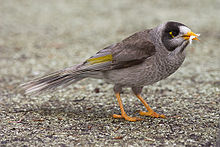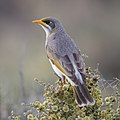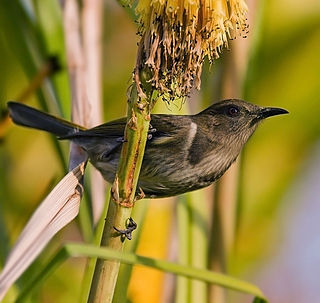
The honeyeaters are a large and diverse family, Meliphagidae, of small to medium-sized birds. The family includes the Australian chats, myzomelas, friarbirds, wattlebirds, miners and melidectes. They are most common in Australia and New Guinea, and found also in New Zealand, the Pacific islands as far east as Samoa and Tonga, and the islands to the north and west of New Guinea known as Wallacea. Bali, on the other side of the Wallace Line, has a single species.
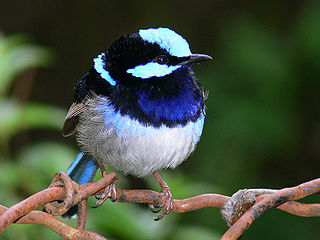
The Australasian wrens are a family, Maluridae, of small, insectivorous passerine birds endemic to Australia and New Guinea. While commonly known as wrens, they are unrelated to the true wrens. The family comprises 32 species in six genera.
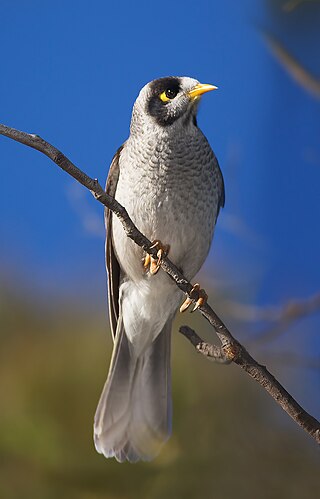
The noisy miner is a bird in the honeyeater family, Meliphagidae, and is endemic to eastern and southeastern Australia. This miner is a grey bird, with a black head, orange-yellow beak and feet, a distinctive yellow patch behind the eye, and white tips on the tail feathers. The Tasmanian subspecies has a more intense yellow panel in the wing, and a broader white tip to the tail. Males, females and juveniles are similar in appearance, though young birds are a brownish-grey. As the common name suggests, the noisy miner is a vocal species with a large range of songs, calls, scoldings and alarms, and almost constant vocalisations, particularly from young birds. One of four species in the genus Manorina, the noisy miner itself is divided into four subspecies. The separation of the Tasmanian M. m. leachi is of long standing, and the mainland birds were further split in 1999.

Anthochaera is a genus of birds in the honeyeater family. The species are endemic to Australia and include the little wattlebird, the red wattlebird, the western wattlebird, and the yellow wattlebird. A molecular phylogenetic study has shown that the regent honeyeater also belongs in this genus.

The bell miner, commonly known as the bellbird, is a colonial honeyeater, endemic to southeastern Australia. The common name refers to their bell-like call. 'Miner' is an old alternative spelling of 'myna', and is shared with other members of the genus Manorina. The birds feed almost exclusively on the dome-like coverings, referred to as 'bell lerps', of certain psyllid bugs that feed on eucalyptus sap from the leaves. The psyllids make these bell lerps from their own honeydew secretions in order to protect themselves from predators and the environment.

The blue-faced honeyeater, also colloquially known as the Bananabird, is a passerine bird of the honeyeater family, Meliphagidae. It is the only member of its genus, and it is most closely related to honeyeaters of the genus Melithreptus. Three subspecies are recognised. At around 29.5 cm (11.6 in) in length, the blue-faced species is large for a honeyeater. Its plumage is distinctive, with olive upperparts, white underparts, and a black head and throat with white nape and cheeks. Males and females are similar in external appearance. Adults have a blue area of bare skin on each side of the face readily distinguishing them from juveniles, which have yellow or green patches of bare skin.

The red-browed pardalote is a small brightly coloured insectivorous passerine, endemic to Australia. A gleaning specialist, they forage primarily in eucalypt trees . The Latin word rubricatus means 'red-ochred' which is descriptive of their orange-red eyebrow. Other common names include red-browed diamondbird, bellbird, cape red-browed, pale red-browed, fawn-eyed, fawn-eyebrowed and pallid or red-lored pardalote.

The scarlet myzomela or scarlet honeyeater is a small passerine bird of the honeyeater family Meliphagidae native to Australia. It was first described by English ornithologist John Latham in 1801. At 9 to 11 cm long, it is the smallest honeyeater in Australia. It has a short tail and relatively long down-curved bill. It is sexually dimorphic; the male is a striking bright red with black wings, while the female is entirely brown. The species is more vocal than most honeyeaters, and a variety of calls have been recorded, including a bell-like tinkling.

The white-naped honeyeater is a passerine bird of the honeyeater family Meliphagidae native to eastern Australia. Birds from southwestern Australia have been shown to be a distinct species, Gilbert's honeyeater, and the eastern birds are more closely related to the black-headed honeyeater of Tasmania. One of several similar species of black-headed honeyeaters in the genus Melithreptus, it dwells in dry sclerophyll eucalypt woodland. Its diet consists of nectar from various flowers, and it also feeds on insects.

The white-cheeked honeyeater is a species of honeyeater that inhabits the east coast and the south-west corner of Australia. It has a large white patch on its cheek, brown eyes, and a yellow panel on its wing.

The white-throated honeyeater is a bird of the honeyeater family Meliphagidae native to New Guinea and eastern and northern Australia. It is 11.5 to 14.5 cm long, olive-green above and white below, with a black head, a white or pale blue patch over the eye, and a white stripe across the nape.

The yellow-throated miner is a species of colonial honeyeater, endemic to Australia. It is also known as the white-rumped miner. The distinctive white rump is easy to observe in the field and distinguishes it from the other miner species. Yellow-throated miners are medium-sized, grey passerines with yellow throat markings, legs, and bare patches around the eye. The common name 'miner' is an alternative spelling of the word myna, mynah or minah, and is shared with other members of the genus Manorina. Though miners were originally named due to their resemblance to the common myna of South and Southeast Asia that shares similar yellow eye-patch and legs, common mynas are from the starling family and are not closely related to the honeyeater family. Common mynas are an aggressive introduced pest in Australia, which causes some confusion with the native aggressive miners.

The helmeted honeyeater is a passerine bird in the honeyeater family. It is a distinctive and critically endangered subspecies of the yellow-tufted honeyeater, that exists in the wild only as a tiny relict population in the Australian state of Victoria, in the Yellingbo Nature Conservation Reserve. It is Victoria's only endemic bird, and was adopted as one of the state's official symbols.

The black honeyeater is a species of bird in the honeyeater family Meliphagidae. The black honeyeater exhibits sexual dimorphism, with the male being black and white while the female is a speckled grey-brown; immature birds look like the female. The species is endemic to Australia, and ranges widely across the arid areas of the continent, through open woodland and shrubland, particularly in areas where the emu bush and related species occur.
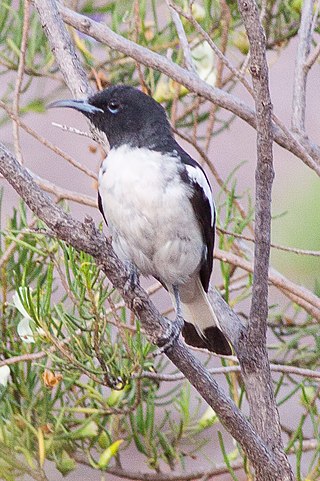
The pied honeyeater is a species of bird in the family of honeyeaters Meliphagidae and the sole species in the genus Certhionyx. This species is also known as the black and white honeyeater or western pied honeyeater.

Epthianura is a genus of bird also known as the Australian chats. Along with the gibberbird in the genus Ashbyia they were once thought to constitute a separate family, the Epthianuridae, although most taxonomists today treat them as a subfamily, Epthianurinae, of the honeyeater family Meliphagidae.

The tawny-crowned honeyeater is a passerine bird native to southern Australia.

The mangrove honeyeater is a species of bird in the honeyeater family Meliphagidae. The species was once considered to be conspecific with the varied honeyeater, but it is now treated as a separate species. These two species form a genus with the singing honeyeater.

The black-chinned honeyeater is a species of passerine bird in the family Meliphagidae. It is endemic to Australia. Two subspecies are recognised. Its natural habitats are temperate forests and subtropical or tropical dry forests.

Gilbert's honeyeater, also known as the Swan River honeyeater or western white-naped honeyeater, is a passerine bird of the honeyeater family Meliphagidae native to southwestern Australia. A mid-sized honeyeater, it is olive-green above and white below, with a black head, nape and throat and a white patch over the eye and a white crescent-shaped patch on the nape. The bill is brownish-black and the eyes a dull red. The sexes have similar plumage.

